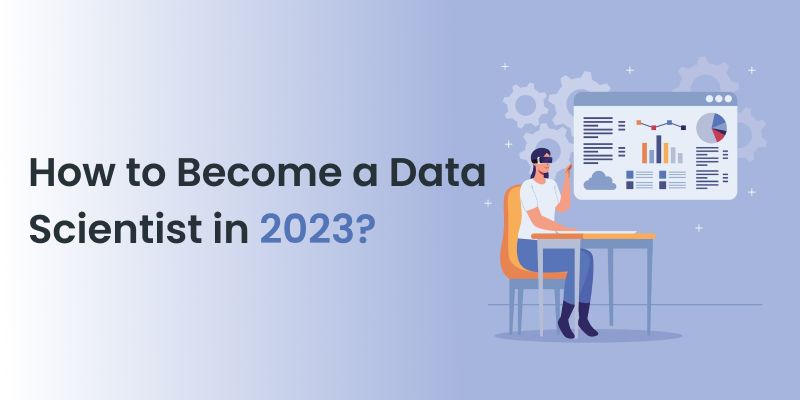
How to Become a Data Scientist in 2023?
Embarking on the journey to become a Data Scientist in 2023 opens doors to a realm where data-driven insights drive innovation. This guide illuminates your path with the latest strategies, technologies, and skills demanded by the evolving landscape. From mastering programming languages and statistical tools to navigating machine learning intricacies, join us as we unravel the steps to thrive in this dynamic field and carve a successful, sought-after career. Welcome to the definitive roadmap for aspiring Data Scientists.
Kickstart your journey to become a Data Scientist in 2023 with our comprehensive guide and top-tier Data Science Course. Master programming, statistics, and machine learning for a successful career.
Becoming a proficient Data Scientist in 2023 demands a strategic approach. Start by building a strong foundation in mathematics, statistics, and programming languages like Python or R. Acquire proficiency in data manipulation, analysis, and visualization techniques. Familiarize yourself with machine learning algorithms and frameworks, and delve into real-world projects to hone your skills. A solid grasp of domain knowledge and effective communication skills are also vital for translating data insights into actionable solutions. Stay updated with the latest industry trends and continuously expand your skill set to excel in this dynamic field.
Introduction to Data Science
In the dynamic landscape of modern technology and business, Data Science emerges as a pivotal discipline that extracts invaluable insights from the vast ocean of data generated daily. Rooted in the convergence of mathematics, statistics, and computer science, Data Science equips professionals to decipher complex patterns, unearth hidden correlations, and make informed decisions. This field holds paramount importance as organizations worldwide strive to harness data for strategic planning and innovation.
Data Science encompasses a multifaceted approach that involves data collection, preprocessing, analysis, and interpretation. Leveraging advanced algorithms and machine learning techniques, Data Scientists uncover trends, predict future outcomes, and identify optimization opportunities. Moreover, the role of a Data Scientist extends beyond technical skills; effective communication and storytelling are crucial to convey intricate findings to both technical and non-technical stakeholders.
As we delve deeper into the digital era, the significance of Data Science continues to grow. The ability to transform raw data into actionable insights empowers businesses, researchers, and policymakers to make evidence-based decisions. This introductory overview merely scratches the surface of the boundless realm of Data Science, a domain that not only offers a promising career path but also fuels innovation across industries.
Building a Strong Foundation
Establishing a robust foundation is paramount for aspiring data scientists. Mathematics and statistics serve as the bedrock of this journey. Proficiency in concepts like probability, linear algebra, and calculus is essential for interpreting complex data patterns and creating accurate models. Mastery of these mathematical principles empowers data scientists to develop algorithms that drive meaningful insights.
Equally crucial is a comprehensive grasp of programming languages. Python and R are pivotal tools for data manipulation and analysis. Python’s versatile libraries like Pandas and NumPy facilitate efficient data handling, while R’s statistical packages enhance analytical capabilities. With these languages at hand, data scientists can confidently approach diverse challenges.
Furthermore, familiarity with databases and data preprocessing techniques is indispensable. Structured Query Language (SQL) proficiency aids in extracting, manipulating, and managing data. Understanding data preprocessing steps, such as handling missing values and normalization, ensures the data’s quality and reliability.
Mastering Essential Tools
Proficiency in essential tools is the cornerstone of a successful data scientist’s skillset. Among these tools, two programming languages stand out: Python and R. Python’s versatility, with libraries like Pandas, NumPy, and Scikit-Learn, empowers data scientists to manipulate, analyze, and model complex data efficiently. R, renowned for its statistical capabilities, offers specialized packages for in-depth analysis.
Python’s clear syntax and extensive community support make it a favorable choice. It enables the creation of machine learning models, data preprocessing, and visualization, all within a single environment. Additionally, R’s statistical libraries and visualization packages, like ggplot2, facilitate nuanced data exploration and presentation.
Utilizing these languages’ capabilities, a data scientist can navigate data complexities with ease. They can implement intricate algorithms, clean and transform data, and craft compelling visualizations for insights. By mastering Python and R, aspiring data scientists gain the adaptability to address a range of challenges and create valuable solutions. As the data landscape evolves, staying up-to-date with these essential tools remains pivotal for carving a successful career in the dynamic field of data science.
Navigating the Data Landscape
Aspiring data scientists must adeptly navigate the intricate data landscape to thrive in this dynamic field. Embracing machine learning forms a cornerstone, demanding understanding of key algorithms like regression, classification, and deep learning. Data visualization, achieved through tools like Matplotlib and Tableau, is crucial for presenting complex insights with clarity. Hands-on projects are pivotal, translating theoretical knowledge into practical skills and building a portfolio that resonates with potential employers.
Staying current with industry trends is paramount; regularly immersing oneself in research papers and engaging with the data science community fosters adaptability. Networking at conferences and workshops fosters connections with peers and mentors. Moreover, the journey entails continuous learning, as the field evolves rapidly. By honing a diverse skill set, embracing ongoing education, and cultivating a robust professional network, aspiring data scientists can effectively traverse the data landscape, unlocking exciting opportunities and contributing meaningfully to the ever-expanding world of data-driven insights.
Conclusion
Aspiring to become a proficient Data Scientist in 2023 demands a strategic and dynamic approach. Embrace a foundation in mathematics, statistics, and programming languages like Python and R. Cultivate expertise in machine learning and data visualization techniques, adapting to the evolving landscape of AI and analytics tools. Engage in hands-on projects to gain practical experience and showcase your skills.
Networking within the data science community, attending workshops, and participating in online forums can foster valuable insights. Continuous learning, staying updated with industry trends, and possessing strong problem-solving abilities will set you on a trajectory towards Data Science excellence in this competitive landscape. Your journey requires dedication, curiosity, and an unwavering commitment to refine your analytical prowess.






